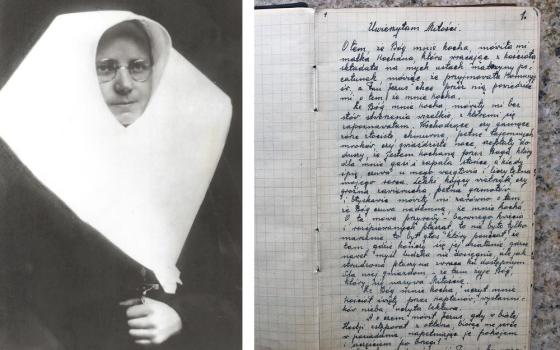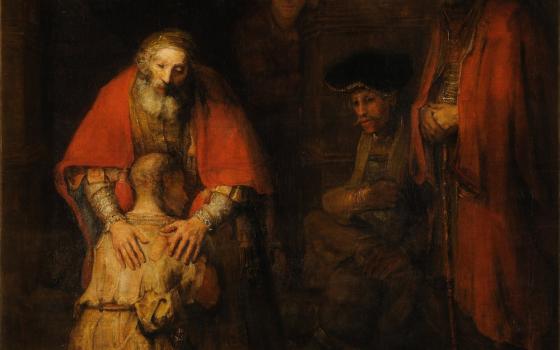
A sign is seen during early voting for the June 2 primary outside the Prince Hall Masonic Temple in Ward 1 in Washington, D.C., May 26. (CQ Roll Call/Tom Williams)
Yesterday, I offered a historical look at the development of "the Catholic vote" — the quintessential swing voting bloc — and how it became decisive in U.S. presidential elections. Today, we will examine why there is no such thing as "the Catholic vote" and why this fiction, nonetheless, is still decisive for U.S. elections.
In the current century, the white suburban vote continues to swing, but the white Catholic vote has increasingly come to mirror that of white evangelicals. This was in part the result of better outreach by the GOP, and part of it is attributable to the fact that the Democrats became increasingly extreme on abortion. Catholics had become more affluent in the last half of the 20th century and more like their suburban neighbors in their sociocultural and political preferences, tilting more and more to the Republicans.
Still, the primary reason white Catholics leaned increasingly Republican is that liberal Catholics stopped being Catholic. White Catholics have followed members of the Protestant mainstream churches toward the exits, becoming "nones," but with fewer defections among conservative Catholics. The effect was to tilt the Catholic vote to the right.
The principal reason Catholics have maintained their share of the population, and continued to be seen as straddling the center of the electorate, is the influx of Latino Catholics. The 1986 immigration reform opened pathways to citizenship for millions of Latinos, mostly from Mexico and Central America, and the number of undocumented in the country doubled in the next 30 years. It is an old law of ecclesiastical politics that Cuban priests are Republicans and Mexican priests are Democrats, and that holds pretty much for the flocks as well.
The Latino Catholic vote has helped to shift whole states like Colorado, Nevada and New Mexico. All three states backed George W. Bush in 2004, but have been in the Democratic column in 2008, 2012 and 2016.
It is likely that Arizona may follow its neighbors this year: In the 2018 midterms, Republican Gov. Doug Ducey easily won reelection, but the Democrats picked up a Senate seat, a House seat and three statewide offices. They appear poised to pick up the other Senate seat this year: Incumbent Sen. Martha McSally, who lost two years ago but was appointed to fill the seat when Sen. John McCain died, is trailing former astronaut Mark Kelly, the husband of former congresswoman and shooting victim Gabby Giffords.
In Texas, Sen. Ted Cruz's 2018 reelection race was astonishingly close, as Beto O'Rouke swamped him in the heavily Hispanic Rio Grande Valley as well as in the large urban areas. Democrats picked up two House seats and narrowed margins for statewide races.
It seems unlikely that the Lone Star state will turn blue in November — President Donald Trump won Texas four years ago by a margin of 52% to 43% — and the Senate contest, featuring incumbent Republican Sen. John Cornyn, is still listed as "likely Republican" by the Cook Political Report. But Republicans might have to spend resources in Texas, resources that will not be available for use elsewhere.
The reach of Latinos is felt beyond the Southwest. Latinos are largely the reason Northern Virginia is lopsidedly Democratic. Virginia is now a bluer shade of purple than it was 10 years ago.
Latinos from Central America, Puerto Rico and the Dominican Republic have moved into the I-4 corridor around Orlando, Florida, and they have balanced the Republican-leaning Cubans in Miami. Over 100,000 immigrants became eligible to vote in Florida in 2017-18 and in Pennsylvania 34,044 immigrants became eligible. There has long been a substantial Puerto Rican community in Lancaster, the heart of Pennsylvania Dutch country.
Advertisement
It is shocking that Trump did better among Latino voters than Mitt Romney did in 2012, but he did, capturing 27% of the Hispanic vote. (I note that there was confusion among pollsters about whether or not Trump won the overall Catholic vote, but 2016 was a hard year for pollsters generally.) Still, Trump's relative success among Latino voters shows that people do not always vote on issues or interests: The strongman persona that Trump epitomizes is not unknown, nor always unpopular, in Latin American history.
A further complicating factor is that the number of Hispanics who self-identify as Catholic has declined. According to the latest Pew Research survey, for the first time, Catholics are no longer a majority among Latinos, with 47%, while the percentage of evangelicals among the Hispanic population has stayed steady, moving up one point to 24%. Jack Jenkins of Religion News Service has already examined some of the state-by-state variations among Hispanic evangelicals who, like their white counterparts, are far more likely to support Trump than any other religious demographic.
What emerges from a quick examination of this shifting landscape? If by "Catholic vote" you mean those who vote this way or that way because they are Catholic, there is no such thing and it is better to render the noun in the plural as "Catholic votes." Increasingly, the political views of Catholics are determined less by their religious affiliation than by their partisan allegiance.
Once you have established party affiliation, their ethnic and racial identification is more determinative of how they will vote than any other additional demographic marker. Latinas and Asian women, both immigrant and U.S.-born, have significantly higher birth rates than white Americans, so we can look to the "Catholic vote" to start tilting back to the Democrats, turning key states blue, even while white Catholics in the Rust Belt make that region more difficult for Democrats.
Demographics are not destiny. When I wrote Left at the Altar in 2008, I voiced the hope that core concepts of Catholic social teaching such as solidarity, the common good and human dignity would become central to the language and the logic of the Democrats, giving them the kind of governing philosophy they lacked and without which they appeared at a disadvantage with Republicans.
Alas, the libertarian language and logic foisted upon the party by the pro-choice groups have been a significant counterweight, making an idol of autonomy. In my conversation with young people, you can see their ambivalence: They know the limits of libertarianism even while they are deeply reluctant to tell someone else what they think should be done.
Then came the pandemic. Autonomy isn't looking so good these days, dressed in camouflage, toting an automatic weapon, shouting, "Don't tread on me!" at your nearest state capitol. If you made a word cloud of the words Democrats and even some Republicans are using these days, I suspect "common good," "solidarity" and "human dignity" would be prominent.
I wish it was because they had all read my book, but in fact this is the result of the coronavirus highlighting in acute form the limits of the Reaganite-Thatcherite, laissez-faire, individualistic worldview. The political moment demands that the Democrats articulate a governing philosophy of some sort and, as far as I can tell, Catholic social teaching is the best available option for them. If they embrace its core ideas, they might not only win the election. They might win a generation.
[Michael Sean Winters covers the nexus of religion and politics for NCR.]
Editor's note: Don't miss out on Michael Sean Winters' latest. Sign up and we'll let you know when he publishes new Distinctly Catholic columns.






